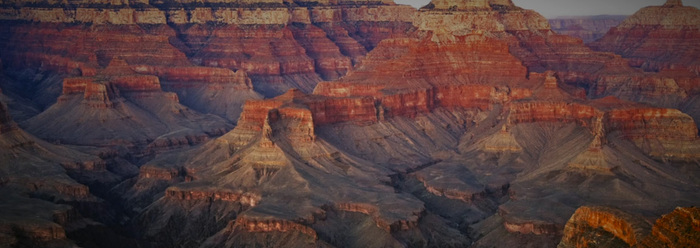Grand Canyon has a special place in my heart. I have spent a lot of time there, both on research trips and the ICR Grand Canyon Tours. To me, Grand Canyon is a clear testimony to the Biblical flood and the young earth.
In school, Grand Canyon was "Exhibit A" for evolution, uniformity, and billions of years. Radioisotope dating "proved" the old earth idea, and the rocks demonstrated slow and gradual processes over those eons. The fossils documented evolution's march through time, with simple creatures at the bottom and complex ones at the top. The Colorado River took 70 million years to erode the Canyon. With such an authoritative story, who could doubt?
Well, there is room to doubt, and even many old-earth advocates are revising their views. Now many geologists who study the Canyon are talking about catastrophic deposition. They are postulating runaway erosion within the last one million years. They are not talking about Noah's flood, but they might as well be!
Keep in mind, these events happened in the unobserved past. Scientists study the results of past processes in the present, and try to reconstruct the past. No one can scientifically "prove" any view of history, creation or evolution, old earth or young earth, uniformity, or Noah's flood.
The best we can do is to identify our view of history, interpret the evidence within that view, and see which view does the best job. In addition, when we do, I am convinced the Biblical view comes out on top. Let us take a brief look at some of the evidence in Grand Canyon.
Catastrophic deposition: Geologists of all persuasions are returning to catastrophism, and nearly every stratum has recently been reinterpreted as the result of water-related processes operating at increased rates and intensities in the past. Evidence of underwater turbidity currents is found in the Tapeats Sandstone, the Redwall Limstone, and others.
Widespread strata: Each stratum covers large areas of the western U.S. Depositional processes of the past covered the entire region, not local areas. The Supai Formation has traditionally been interpreted as a delta deposit, but has laterally extensive thin members, unlike modern deltas.
Fossils: The fossils at every level are extremely complex, but the ones in the bottom layers, such as the trilobites, are even more complex than the ones nearer the top, such as corals. No evolutionary sequence here!
Lack of erosion on the plateau: The Colorado Plateau is thought to have been uplifted some 70 million years ago, but the stratum on top at the time of uplift is still on top, a flat, featureless plain, hardly touched by erosion.
Erosion of Grand Canyon: The Canyon was eroded but the present Colorado River was not the erosive agent. Erosion was rapid, not so long ago according to dating efforts, and the waters carried the debris far to the west, not like the modern Colorado River. Furthermore, the main erosional features are typically those of soft sediments, not hard rock.
Soft sediment deformation: According to the evolutionary view, many rocks were already hundreds of millions of years old at the time of uplift. However, the Tapeats Sandstone was clearly bent while it was still soft, unconsolidated sediment, not as hard rock. Evidently, it was not very old.
Radioisotope dating: Results from radioisotope dating efforts are not at all consistent with the old-earth study. In fact, volcanic basalts on the rim date as older than the deeply buried Cardenas Basalts.
Other evidences could be cited. In fact, I recommend the new book, Grand Canyon: Monument to Catastrophe, 1994, edited by Dr. Steve Austin of ICR, in which these and other points are fully discussed. Grand Canyon is not "Exhibit A" for evolution. Rather, it is better understood as the result of the great Flood.
*Dr. John Morris is the President of ICR.




